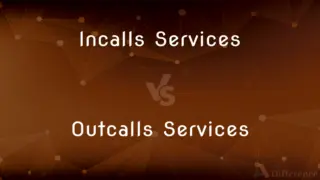Undertenant vs. Tenant — What's the Difference?
Edited by Tayyaba Rehman — By Fiza Rafique — Published on August 13, 2024
An undertenant leases from a tenant who is already leasing from a landlord, focusing on subleasing rights, while a tenant directly leases from a landlord, holding the primary lease agreement.

Difference Between Undertenant and Tenant
Table of Contents
ADVERTISEMENT
Key Differences
An undertenant is an individual or entity that enters into a lease agreement with a tenant, who already holds a lease with the property owner. This arrangement allows the undertenant to occupy the property or a portion of it, under specific conditions agreed upon with the tenant. On the other hand, a tenant directly leases property from the landlord or property owner, establishing a primary legal relationship and holding the master lease for the property.
While an undertenant's rights and obligations are defined by the sublease agreement made with the tenant, they often have limited rights compared to the original tenant. These limitations can include restrictions on the use of the property, the duration of the sublease, and the ability to further sublet. Conversely, a tenant typically enjoys broader rights under the lease with the landlord, including the right to use, occupy, and enjoy the property within the terms of the lease.
The legal relationship of an undertenant with the property owner is indirect and governed through the tenant, meaning the undertenant's occupancy and rights are subject to the tenant maintaining a good standing lease with the landlord. Whereas a tenant's legal relationship is direct with the landlord, making them directly responsible for fulfilling lease obligations, such as paying rent and maintaining the property.
Undertenants may face eviction if the primary tenant violates their lease with the landlord, even if the undertenant has not breached their sublease terms. This highlights the dependent nature of the undertenant's occupancy on the tenant's lease compliance. In contrast, tenants face eviction directly from the landlord only for their own lease violations, providing a more stable occupancy as long as they comply with lease terms.
The process of becoming an undertenant usually requires the approval of the original tenant and potentially the landlord, depending on the terms of the primary lease. This process can include background checks and agreements that align with the original lease's conditions. However, someone becoming a tenant will deal directly with the landlord or their representatives, undergoing a lease application process that typically involves credit checks, references, and a security deposit.
ADVERTISEMENT
Comparison Chart
Lease Agreement
Sublease from tenant
Direct lease with landlord
Legal Relationship
Indirect with landlord, direct with tenant
Direct with landlord
Rights
Limited by sublease terms
Broad, as outlined in lease
Stability
Depends on tenant's lease compliance
Directly related to own compliance with lease
Eviction Risk
High, depends on tenant's status
Based on own actions
Approval Process
Requires tenant (and possibly landlord) approval
Direct application to landlord
Duration of Stay
Usually shorter, defined by sublease
Can be long-term, as defined by lease
Responsibility
Limited to terms of sublease
Broad, covering rent, maintenance, etc.
Ability to Sublease
Typically not allowed
Often allowed with landlord's consent
Relationship with Owner
None directly, only through tenant
Direct, with legal and financial obligations
Compare with Definitions
Undertenant
Someone with no direct legal relationship with a property owner.
Liam, an undertenant, dealt with the tenant for all housing issues, not the landlord.
Tenant
An individual who leases property directly from a landlord.
Alex became a tenant by signing a lease agreement directly with the property owner.
Undertenant
A sublessee occupying property under an agreement with the original tenant.
As an undertenant, Mia had to adhere to both the sublease and the primary lease rules.
Tenant
Someone with the right to use and occupy leased property.
As tenants, they had the exclusive right to use the property as per the lease.
Undertenant
Occupant of a rental property under a secondary lease agreement.
Sarah's undertenant status required her to pay rent to the tenant, not directly to the landlord.
Tenant
A lessee with a direct legal relationship with a property owner.
Kim, the tenant, negotiated lease terms directly with the landlord.
Undertenant
A tenant under a tenant, with rights dependent on the primary lease.
As an undertenant, Zoe had limited rights compared to the primary tenant.
Tenant
The primary leaseholder with direct responsibility to the landlord.
As a tenant, Jordan was responsible for all lease obligations, including rent and maintenance.
Undertenant
An individual who subleases part or all of a leased property.
Jake became an undertenant by subleasing an apartment from the primary tenant.
Tenant
The main occupant under a lease agreement with a landlord.
As the tenant, Chris could decide to sublease the apartment with the landlord's approval.
Undertenant
(property law) subtenant.
Tenant
One that pays rent to use or occupy land, a building, or other property owned by another.
Undertenant
The tenant of a tenant; one who holds lands or tenements of a tenant or lessee.
Tenant
A dweller in a place; an occupant.
Tenant
One who holds or possesses lands, or other real estate, by any kind of right, whether in fee simple, in common, in severalty, for life, for years, or at will; also, one who has the occupation or temporary possession of lands or tenements the title of which is in another; - correlative to landlord. See Citation from Blackstone, under Tenement, 2.
Tenant
One who has possession of any place; a dweller; an occupant.
The hhappy tenant of your shade.
The sister tenants of the middle deep.
Tenant
Someone who pays rent to use land or a building or a car that is owned by someone else;
The landlord can evict a tenant who doesn't pay the rent
Tenant
A holder of buildings or lands by any kind of title (as ownership or lease)
Common Curiosities
How does an undertenant differ from a tenant?
An undertenant has a sublease with a tenant and an indirect relationship with the landlord, whereas a tenant has a direct lease and relationship with the landlord.
Can an undertenant sublease their space?
Typically, undertenants cannot sublease their space as their rights are more restricted and usually bound by the original lease terms.
What responsibilities does an undertenant have?
Undertenants must adhere to their sublease terms, which typically include paying rent to the tenant and maintaining the leased space's condition.
How does one become an undertenant?
By entering into a sublease agreement with a current tenant, often with the landlord's knowledge or approval.
What is an undertenant?
An undertenant is someone who leases property from a tenant, not directly from the property owner.
Who has more rights, an undertenant or a tenant?
A tenant generally has more rights, including broader use of the property and direct legal remedies against the landlord.
Can a tenant evict an undertenant?
Yes, if the undertenant violates the sublease terms, the tenant can initiate eviction proceedings.
Do undertenants need approval from the landlord?
This depends on the primary lease terms; sometimes, both tenant and landlord approval is required for subleasing.
What are the risks for an undertenant?
Undertenants risk eviction if the primary tenant violates their lease, as their right to occupy depends on the tenant's lease standing.
What are the key factors to consider before becoming an undertenant?
Potential undertenants should consider the stability of the tenant's lease, the terms of the sublease, and their own rights and obligations under this arrangement.
Is an undertenant's lease duration the same as the tenant's?
No, an undertenant's lease is typically shorter and bound by the duration of the tenant's original lease.
What legal protections do undertenants have?
Legal protections vary by jurisdiction but generally are limited compared to those of tenants.
What happens if an undertenant has a dispute with the tenant?
Disputes are usually resolved based on the sublease agreement and may require mediation or legal intervention.
Who does an undertenant pay rent to?
An undertenant pays rent directly to the tenant, not to the landlord.
Can a tenant change the terms of an undertenant's sublease?
Not without the undertenant's agreement, unless such provisions were included in the original sublease terms.
Share Your Discovery

Previous Comparison
However vs. Albeit
Next Comparison
Incalls Services vs. Outcalls ServicesAuthor Spotlight
Written by
Fiza RafiqueFiza Rafique is a skilled content writer at AskDifference.com, where she meticulously refines and enhances written pieces. Drawing from her vast editorial expertise, Fiza ensures clarity, accuracy, and precision in every article. Passionate about language, she continually seeks to elevate the quality of content for readers worldwide.
Edited by
Tayyaba RehmanTayyaba Rehman is a distinguished writer, currently serving as a primary contributor to askdifference.com. As a researcher in semantics and etymology, Tayyaba's passion for the complexity of languages and their distinctions has found a perfect home on the platform. Tayyaba delves into the intricacies of language, distinguishing between commonly confused words and phrases, thereby providing clarity for readers worldwide.













































